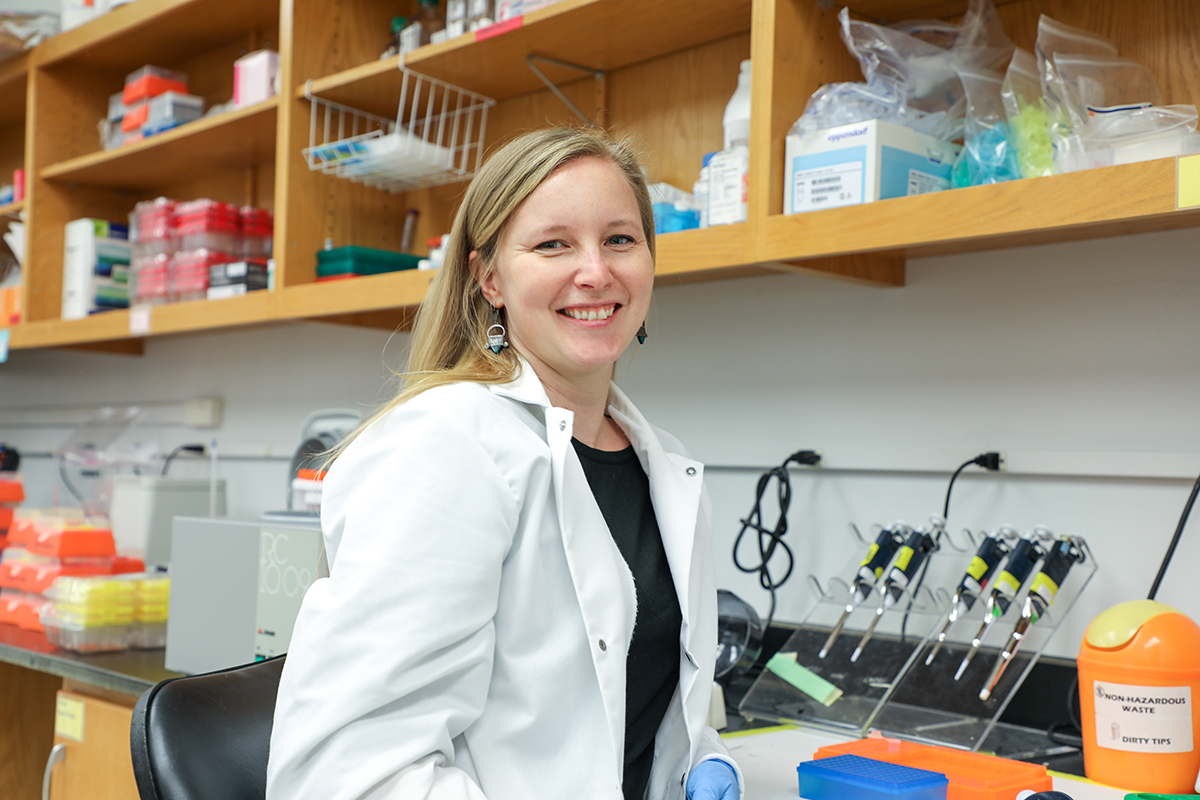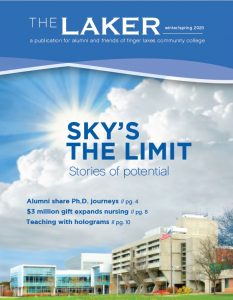
Cara Love was a homeschooler who needed a high school equivalency diploma as a bridge to college. While prepping for the state exam at Finger Lakes Community College, she found a place to begin exploring her fascination with human impacts on the natural world. Today she is studying the effects of the Chernobyl nuclear disaster on wolves.
Cara is among the alumni who credit FLCC as the springboard for careers in research. In each case a person or program at the college was just what they needed at just the right moment.
Nationally, community colleges get attention for their agility in developing applied programs to meet local needs. Think of courses for wind turbine technicians at two-year schools in the Midwest and FLCC’s viticulture and wine technology degree.

It is not uncommon, however, for students who got their start at community college to pursue doctoral degrees. The National Student Clearinghouse reports that 11 percent of those who earned doctoral degrees in 2016-17 entered higher education at a community college. The proportion was highest in the health and clinical sciences in which 21.5 percent of all those who earned doctoral research degrees started at a two-year school.
Cara arrived at FLCC at age 17. Homeschooled in Naples, she quickly moved through her high school equivalency program into an eclectic mix of college classes: Wilderness Camping, Spanish, Cultural Anthropology, Business Mathematics, Foundation Drawing, Computing in the Information Age, and Biology of Man: Genetics, Evolution and Environment.
“I realized how much I loved the atmosphere at FLCC,” she said. “Some of the best teachers I’ve ever had were at FLCC. They took the time to inspire and encourage my curiosity about the world around me as well as explore my own interests and new topics.”
After FLCC graduation, she moved to Chile and earned a certificate to teach English as a Foreign Language at Andrés Bello National University. She returned to the U.S. a year later to complete a bachelor’s degree at the SUNY College of Environmental Science and Forestry.

After completing her bachelor’s, Cara took part in an International Crane Foundation project to preserve crane habitat in a remote region of Russia before returning to the U.S. to look for additional work in research. She landed a technician position at the University of Georgia’s Savannah River Ecology Laboratory on a U.S. Department of Energy facility that also had a decommissioned nuclear power plant.
Here, she began to study amphibians at the site to determine if they had been affected by the industrial practices and resulting environmental contamination. This eventually led to related work, which would become her doctoral project in the Chernobyl Exclusion Zone, a 1,000 square mile area where fallout from the 1986 nuclear plant explosion is highest.
“I’m exploring how long-term exposure to environmental contaminants impacts the health and genetic structure of wolves and raccoon dogs,” she explained. Raccoon dogs are east-Asian relatives of foxes imported to Russia for their fur.
Since 2014, she has made several trips to the exclusion zone, largely in Belarus, to trap and collar wolves and raccoon dogs with GPS and radiation monitors. Cara is specifically studying parasites and gene expression patterns in these animals to understand the health implications of living in this habitat.
The work is not without risk, but Cara and her fellow researchers wear a device called a dosimeter to alert them to leave an area if their radiation exposure climbs too high.
What keeps her working in less than ideal conditions?
Cara credits her “seemingly insatiable overall curiosity about the world. I am curious how the world works, how people and wildlife interact with the world around them and each other, and am intrigued by the complexity that pulls it all together.”
She has found no obvious physical deformities but has discovered differences in the immune function and metabolic rates of the animals. This is important because wolves can be used as a model for humans. Like humans, they have a long enough life span for cancers to develop.
Sorting out what is happening with the animals in the exclusion zone is difficult. Wolves and raccoon dogs are considered nuisance animals and locals can get the equivalent of $100 to kill a wolf and $10 for a raccoon dog. The bounties – another human impact – may be driving the animals into the exclusion zone, where the wildlife density is higher. The question is whether the radiation or density or some mix of both accounts for changes in the animals’ cellular functions.
She expects to complete her dissertation on the health and genetic structure of wildlife in contaminated environments in spring 2020. After that, she said, “I’m going to keep exploring questions that fascinate me.”
Tomorrow, Part 4: Open to Possibilities
Alumni: Stay in touch
We love learning your stories and sharing them. Help us stay in touch by updating your contact information. Click here for an online form to record your address and any news.

